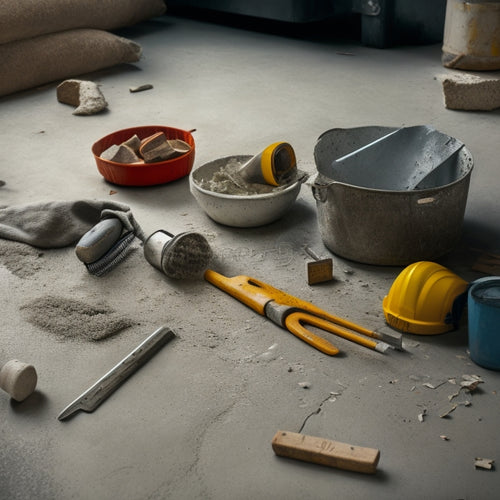
Tools for Removing Concrete in Tight Spaces
Share
When tackling concrete removal in tight spaces, you'll need specialized tools that facilitate precision and control. Pneumatic breakers, electric hammer drill options, and rotary hammers for demolition offer compact designs and high-torque performance for efficient breaking. Compact demolition saws with specialized blades and hydraulic concrete splitters provide added precision. Handheld chisel sets, narrow-angle grinder tools, and specialty pry bars for concrete are designed for precision work. By selecting the right tools and mastering techniques, you can guarantee quick and safe concrete removal in confined areas. Now, explore the specific features and benefits of each tool to optimize your results.
Key Takeaways
• Pneumatic breakers and electric hammer drills are ideal for removing concrete in tight spaces due to their compact size and lightweight design.
• Rotary hammers and demolition hammers are essential for smaller and larger-scale concrete removal tasks, respectively, with cordless options providing convenience and flexibility.
• Compact demolition saws with adjustable handles and rotating heads facilitate precision in tight spaces, and blade selection is critical for tool performance and efficiency.
• Handheld chisel sets with the right chisel bits, such as point and flat chisels, are effective for precision work in tight spaces and can withstand the rigors of breaking tough concrete.
• Ergonomic design considerations, including compact design, lightweight materials, and weight distribution, are crucial for minimizing fatigue and enhancing control in tight spaces.
Pneumatic Breakers for Tight Spaces
When working in cramped areas, you'll often find pneumatic breakers to be the most effective tool for removing concrete, as their compact size and lightweight design allow for increased maneuverability in tight spaces.
The pneumatic breaker advantages in these situations are undeniable. You'll appreciate the ease of handling and control, enabling you to precision-break concrete in areas where other tools can't reach.
To maximize your efficiency in tight spaces, employ tight space techniques such as using shorter bits and adapting your stance to maintain balance and leverage.
Additionally, consider using a breaker with a 90-degree swivel handle, allowing you to access corners and edges with ease.
By mastering these techniques and leveraging the advantages of pneumatic breakers, you'll be able to remove concrete quickly and safely, even in the most confined areas.
With the right tool and techniques, you'll be able to tackle complex demolition projects with confidence, achieving professional-grade results in no time.
Electric Hammer Drill Options
Three electric hammer drill options stand out for their ability to remove concrete efficiently: rotary hammers, demolition hammers, and combination hammers. When choosing the right tool for your project, consider the power ratings and cordless options available. You'll want to select a drill that provides sufficient power to break through concrete without excessive vibration or fatigue.
Rotary hammers, for instance, offer high-torque performance and are ideal for smaller-scale demolition projects. Demolition hammers, on the other hand, pack more punch and are better suited for larger-scale concrete removal. Combination hammers, as the name suggests, offer a combination of rotary and demolition capabilities, making them a versatile choice for various tasks.
When evaluating electric hammer drills, pay attention to their power ratings, measured in amps or watts. A higher power rating typically translates to increased drilling speed and efficiency.
Additionally, consider cordless options, which offer greater convenience and flexibility on the job site. With the right electric hammer drill, you'll be able to tackle concrete removal projects with confidence and precision.
Rotary Hammers for Demolition
You'll typically reach for a rotary hammer when tackling smaller-scale demolition projects that require high-torque performance and precise control. This powerful tool is ideal for breaking up concrete, brick, or block in tight spaces, such as bathroom renovations or kitchen remodels.
When choosing a rotary hammer, consider the type of bit you'll need, as well as the hammer's power output and weight. For example, a hammer with a high torque output will be better suited for breaking up thick concrete, while a lighter hammer may be more suitable for smaller tasks.
To get the most out of your rotary hammer, it's crucial to master rotary hammer techniques, such as proper grip and stance, as well as controlled strikes. Additionally, having the right rotary hammer accessories, like chisels, points, and dust collection systems, will help you work efficiently and safely.
When working in tight spaces, consider using a rotary hammer with a compact design and adjustable handle to improve maneuverability. By selecting the right rotary hammer and accessories, and honing your techniques, you'll be able to tackle even the most challenging demolition projects with confidence.
Compact Demolition Saws
When you're choosing a compact demolition saw, you'll want to reflect on the blade selection that's right for your project.
You'll need to think about the type of concrete you're working with and the size of the area you need to clear.
Blade Selection Matters
Selecting the right blade for your compact demolition saw is essential, as it directly impacts the tool's performance, efficiency, and overall productivity on the job site. You need to choose a blade that's optimized for the specific task at hand.
When it comes to blade types, you'll typically have a choice between diamond blades, abrasive blades, and carbide-tipped blades. Diamond blades are ideal for cutting through hard materials like concrete, asphalt, and stone, while abrasive blades work better on softer materials like brick and block. Carbide-tipped blades offer a good balance between speed and durability.
The blade material you choose is also critical. High-carbon steel blades are a popular choice for compact demolition saws, as they offer a good balance between strength and affordability. However, if you're working in harsh environments or with extremely hard materials, you may want to take into account blades made from more durable materials like tungsten carbide or diamond-coated steel.
Space-Saving Design Features
Three key space-saving design features to look for in a compact demolition saw are a compact body, folding or retractable handles, and a rotating head, all of which enable you to navigate tight spaces and corners with ease.
These design features are essential when working in confined areas, as they allow you to maneuver the saw with precision and control. A compact body reduces the overall size of the saw, making it easier to fit into tight spaces, while folding or retractable handles enable you to adjust the saw to fit your body and the space you're working in.
| Design Feature | Benefits |
|---|---|
| Compact body | Reduced size for easy maneuverability |
| Folding or retractable handles | Adjustable to fit your body and workspace |
| Rotating head | Enables precise cutting in tight corners and spaces |
When selecting a compact demolition saw, look for models with modular tool storage and ergonomic handle design. These features will enhance your overall experience and improve your productivity in tight spaces. By considering these space-saving design features, you'll be able to tackle even the most challenging concrete removal projects with confidence.
Hydraulic Concrete Splitters
You operate hydraulic concrete splitters by using a hydraulic cylinder to drive a wedge into the concrete, generating immense force that cracks and breaks the material. This process allows for controlled and precise demolition, making hydraulic splitters ideal for removing concrete in tight spaces.
One of the primary hydraulic advantages of these tools is their ability to apply intense pressure, often exceeding 100 tons, to break through even the toughest concrete. This results in increased splitter efficiency, as you can complete jobs faster and with less effort.
Additionally, hydraulic splitters are designed to reduce vibration and noise, making them a more comfortable and safer option for operators.
When selecting a hydraulic concrete splitter, consider the hydraulic pressure, wedge design, and overall build quality to ascertain you're getting a tool that can handle your specific concrete removal needs.
Handheld Chisel Sets
When selecting a handheld chisel set for concrete removal, you'll want to take into account the type of chisel bits included, as they'll impact the effectiveness of the tool.
You'll need to choose a set that includes bits specifically designed for concrete, such as point chisels or flat chisels, to guarantee you're getting the best results.
Additionally, a compact design is essential, as it will allow you to work in tight spaces and minimize fatigue.
Chisel Bit Selection
Selecting the right chisel bits for your handheld chisel set is crucial, as it directly impacts the efficiency and effectiveness of concrete removal. You want to choose bits that can withstand the rigors of breaking up tough concrete without compromising their integrity.
When selecting chisel bits, consider the following factors:
-
Chisel types: Claw chisels, flat chisels, and pointed chisels each serve a specific purpose. Claw chisels are ideal for prying and breaking, while flat chisels are better suited for scraping and smoothing. Pointed chisels are perfect for precision work and getting into tight spaces.
-
Chisel materials: Bits can be made from high-carbon steel, tungsten carbide, or diamond-coated materials. High-carbon steel bits are durable and affordable, while tungsten carbide bits offer superior strength and longevity. Diamond-coated bits are ideal for extreme concretes and provide exceptional wear resistance.
-
Bit size and shape: Verify the chisel bits fit comfortably in your handheld set and are suitable for the specific task at hand. Larger bits may be needed for heavier concrete, while smaller bits are better for precision work.
- Bit coatings and surface treatments: Some chisel bits feature specialized coatings or surface treatments to reduce wear, improve grip, or enhance durability. Consider these features when selecting the right bits for your concrete removal project.
Compact Design Matters
A compact handheld chisel set's design considerably influences its overall performance, making it essential to prioritize a set that balances power and portability for efficient concrete removal. You'll want to look for a set that combines ergonomic handles with lightweight materials, allowing you to work comfortably in tight spaces for extended periods.
When selecting a handheld chisel set, consider the weight distribution and grip comfort. A well-designed set will enable you to maintain control and precision, even in confined areas. In addition, lightweight materials will reduce fatigue, allowing you to focus on the task at hand.
Ergonomic handles will also play a vital role in reducing strain on your hands and wrists, enabling you to work for longer durations without discomfort. Moreover, a compact design will provide you with the agility to navigate tight spaces and remove concrete with precision.
Narrow-Angle Grinder Tools
You'll frequently reach for narrow-angle grinder tools when tasked with removing concrete in tight spaces or corners. These specialized tools are designed to excel in narrow angle applications, providing the precision and control needed to tackle complex concrete removal tasks.
When working in cramped spaces, it's important to choose a grinder that can fit comfortably in your hand and navigate tight corners. Look for tools with compact designs, adjustable handles, and ergonomic grips to reduce fatigue and improve control.
Proper grinder maintenance is also vital to guarantee peak performance and extend the tool's lifespan. Here are some key considerations:
-
Regularly inspect and replace worn or damaged grinding wheels to maintain efficiency and prevent overheating.
-
Clean the tool's air vents and filters to guarantee proper airflow and reduce dust buildup.
-
Lubricate moving parts to reduce friction and wear.
- Store the tool in a dry, protected area to prevent corrosion and damage.
Specialty Pry Bars for Concrete
When tackling concrete removal projects that require precision and leverage, turn to specialty pry bars designed specifically for this task. These bars are crafted from specialty materials to provide the strength and durability needed to tackle tough concrete removal jobs. Their ergonomic handles are designed to reduce fatigue and provide a comfortable grip, allowing you to work for extended periods without strain.
Here are some key features to look for in specialty pry bars for concrete removal:
| Feature | Description |
|---|---|
| Material | High-strength, heavy-duty steel or specialty alloys |
| Handle | Ergonomic design for reduced fatigue and improved grip |
| Tip | Angled or curved for ideal leverage and precision |
| Length | Ranges from 12 to 36 inches for versatility and reach |
Frequently Asked Questions
Can I Use a Regular Drill Bit to Break up Concrete?
When you're considering concrete drill techniques, you might wonder if a regular drill bit can break up concrete. The answer is, it's not the best choice. You'll struggle to make progress and risk damaging your drill.
Instead, focus on bit selection criteria like carbide-tipped bits or diamond-coated bits, designed specifically for concrete. They'll help you efficiently break up concrete, saving you time and effort.
How Do I Protect Myself From Dust and Debris During Demolition?
When demoing concrete, you'll create a massive amount of dust and debris. To protect yourself, you'll need to gear up properly.
Start by wearing a dust mask with a HEPA filter, which captures 99.97% of particles as small as 0.3 microns.
Next, set up debris barriers around your work area to contain the mess.
Are There Any Eco-Friendly Options for Removing Concrete?
As you stand amidst the rubble, you wonder if there's a way to demolish concrete without harming the planet. The answer is yes!
You're on the cusp of discovering sustainable demolition methods that prioritize the environment. Explore green alternatives like chemical demolition agents, which break down concrete without releasing harmful toxins.
These eco-friendly options are revolutionizing the industry, allowing you to dismantle concrete structures with a clear conscience.
Can I Rent These Tools or Do I Need to Buy Them?
When deciding on equipment, you'll need to weigh rental options against purchasing considerations.
Renting might be a cost-effective choice for one-time or infrequent use, but it may limit your access to specialized tools.
On the other hand, buying equipment provides long-term convenience and flexibility, but it requires a significant upfront investment.
Consider your project's scope, frequency, and budget to determine the best approach for your needs.
What Safety Features Should I Look for in a Concrete Removal Tool?
When it comes to choosing a concrete removal tool, don't cut corners - prioritize safety above all.
You'll want to look for safety gear such as dust masks, gloves, and safety glasses to protect yourself from debris and dust.
Additionally, consider the tool weight, as a heavier tool can be more difficult to maneuver and may lead to fatigue.
Opt for a tool with a comfortable grip and balanced design to guarantee you can work efficiently without compromising your safety.
Conclusion
You've navigated the tight spots, and now it's time to wrap up.
Like a conductor leading an orchestra, you've harmoniously selected the right tools for removing concrete in tight spaces.
From pneumatic breakers to handheld chisel sets, each instrument played its part in your demolition symphony.
With this ensemble of tools, you're ready to tackle even the most challenging concrete removal projects, no matter how small the space.
Related Posts
-

10 Best Tools for Sealed Concrete Flooring on Budget
When starting on a sealed concrete flooring project on a budget, you'll need to prioritize essential tools without sa...
-

Top 10 Concrete Repair Tools for Small Fixes
You'll need the right tools to tackle small concrete repairs efficiently and effectively. When it comes to small fixe...
-

What Tools Do You Need for Concrete Flooring
You'll need a thorough arsenal of specialized tools to achieve a high-quality, professional-looking concrete floor, i...


